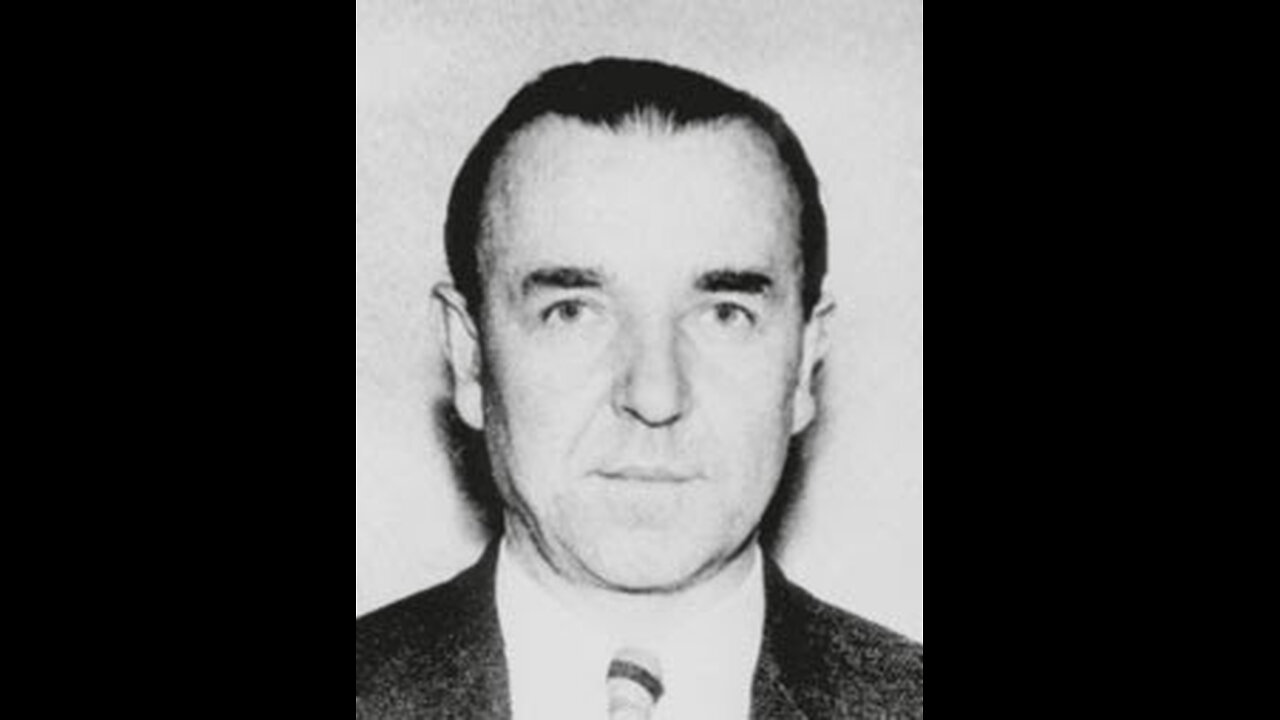Premium Only Content

Polish Genius : Wsiewolod Jakimiuk
Eng. Wsiewołod Jan Jakimiuk ("Jaki") 1902 - 1991 / He was born on January 5, 1902 in Kożyno in Podlasie. He died in September 1991 in Paris and was buried there in the Saint-Ouen cemetery (section 33-17-18). An outstanding, world-class aviation engineer and aircraft designer in Poland, Canada, Great Britain and France. He graduated in mathematics from the Stefan Batory University in Vilnius and aviation studies from the Ecole Nationale Superieur d'Aeronautique in Paris. He was the son of an Orthodox priest. He spent his childhood and teenage years in Poland, where he was raised in an atmosphere of service to others and loyalty to the Homeland.
Education
He graduated from high school in Vilnius. He completed his higher education at the Faculty of Mathematics and Natural Sciences of the Stefan Batory University in Vilnius, receiving a master's degree in mathematics
in 1925. In the years 1927-29 he studied in Paris at the École Nationale Superieur d'Aeronautique, where he obtained a diploma in aviation engineering (1929) and at the Sorbonne, where he obtained a bachelor's degree (license de l'Aeronautique General). Before the war in Poland
In 1939, he started working as an aircraft designer and strength tester at the National Aviation Works in Warsaw, in the team of the famous Polish aircraft designer Zygmunt Puławski, designing the PZL P.11 fighter aircraft. After Puławski's tragic death on March 21, 1931 in the crash of the PZL P.12 amphibious plane, he took over the management of his team designing serial versions of the PZL P.7 and PZL P.11 aircraft for the Polish aviation.
He continued Puławski's work using his unique wing called the "Puławski wing", thinned at the fuselage and bent in the form of a gull wing, allowing very good visibility from the cockpit for the pilot.
During his work at PZL, he developed the following aircraft:
– P.7a for Polish aviation (1932, 150 units built). P.11a (1934, 50 pieces) and P.11c (1935, 150 pieces), for export to Romania P.11b (1933 - 50 pieces) and the licensed version also to Romania P.11f (1936 - 95 pieces) and in version developed for Polish aviation P.11g (1939 - prototype). As an export variant of the Puławski P.7 and P.11 aircraft, Eng. Jakimiuk developed the PZL P.24 in 1933 in versions P.24A and P.24B and later versions P.24C (1936), P.24E (1937), P24.F, P24.G, P.24.H (1937) and P24J (1939). PZL also produced export versions: 14 P.24B for Bulgaria, 20 P.24A and P.24.C for Turkey, 6 P.24E for Romania, 36 P24.F and 36 P24.G for Greece and produced under license in Romania – 25 P.24E and in Turkey – 24 P.24C and 24 P.24G.
In the years 1931-33, he directed the development of the PZL P.8/1 and PZL P.8/11 fighter aircraft and developed their PZL P.28 development project. In 1935, together with Eng. T. Baudouin de Courtnay, he designed and patented a timing device for controlling the pilot's on-board machine gun. This number of fighter aircraft produced, perfect for those times, was a great achievement of PZL and their main designer himself. It was a continuation of the innovative work of Engineer Zygmunt Puławski, who was the main creator of the first aircraft of this series.
In the years 1936-38, Eng. Jakimiuk gave lectures on the strength of materials at the chair of the world-famous Polish mechanic, prof. Ph.D. engineer Maksymilian Tytus Huber, at the Warsaw University of Technology.
In 1936, he was tasked with designing a medium-range passenger plane for LOT Polish Airlines, which would be competitive with the American Douglas DC-2 and Lockheed L-10 planes. This plane was named PZL.44 Wicher. Its prototype made its first flight on March 13, 1938
and then underwent operational tests at PLL LOT. However, the plane did not enter mass production due to the lower price of Lockheed L-14 aircraft and PZL accepting new contracts for Polish military aviation. The PZL.44 Wicher prototype was seized in Lviv after the city was occupied by the Soviets. In 1937, he designed a new PZL.50 Jastrząb fighter aircraft, the design of which won the internal competition for a fighter aircraft at PZL. Eng. J. Jakimiuk designed it together with Eng. J. Zbrożek, Eng. Lt. M. Kaczanowski and Eng. P. Bielkowicz. The Jastrzębie prototype was first flown in February 1939 and the plane entered mass production, but the outbreak of war on September 1, 1939 prevented the completion of mass production. The produced Jastrzębie prototype crashed during the evacuation near Rawa Ruska on September 3, 1939. Jakimiuk designed several versions of this fighter with different engines: Gnôme-Rhône 14 and Bristol Taurus 14 and Hispano Suiza 12, designated PZL P.63 Kania. The prototype was produced with a Pegaz engine and achieved a speed of 430 km/h, instead of the required 500 km/h.
Engineer Jakimiuk was slightly injured by shrapnel during the bombing of the Airframe Factory No. 1 of the State Aviation Works (PZL) in Warsaw at Okęcie-Paluch. He was evacuated together with the plant's technical staff to Romania and then to France. In France
Engineer Jakimiuk was the first of the evacuees from the Polish aviation technical staff to get a job in November 1939 in the French aviation industry and became the head of a team of Polish engineers at the Societé National des Constructions Aéronautiques - Sud Est plant in Argentueil near Paris. The following engineers worked with him on the modification of the French SE-100 fighter and LeO-45 bomber: Dr. Aleksander Grzędzielski, Kazimierz Korsak, Jan Lewczuk, Jerzy Płoszajski and K. Wolski. In May 1940, he contacted the British aviation company de Havilland, which offered him the position of chief designer in its Canadian branch de Havilland Aircraft of Canada in Downsview, then a suburb of Toronto. In Canada
In the summer of 1940, Eng. Jakimiuk went to Canada, where he obtained approval for Canadian visas (with the help of the Polish government in London) and for a loan for travel costs for 200 Polish aviation specialists from the Canadian aviation industry. The total number of Polish engineers and technicians as well as technical and university specialists who came to Canada reached 625 people by the end of the war. This will require further research
and detailed research (both in Polish documents in London and in government documentation in Ottawa). In March 1941, Eng. Jakimiuk brought to Canada engineers he knew from both PZL and PWS (Podlaska Wytwórnia Samolotów). They included the following famous Polish aviation engineers with an excellent reputation: Eng. Wacław Czerwiński, graduate of the Lviv University of Technology, former chief designer of Podlaska Wytwórnia Samolotów, engineer. Kazimierz Korsak, former designer of PZL Airframe Factory, engineer. Mieczysław Kurman, former technical director of PZL Airframe Factory, Ph.D. Eng. Wiesław Stępniewski ("Steppy"), one of the most outstanding Polish, Canadian and later American specialists. aerodynamics, former engineer coordinator of PZL Airframe Factory. Soon they added: engineer. Tadeusz Tarczyński, outstanding Polish, Canadian and American aircraft designer, former designer. in the PZL Design Office and Eng. Zygmunt Jarmicki former head of the accessories section of Podlaska Wytwórnia Samolotów. The Polish team at de Havilland Canada made invaluable contributions not only to the war production of aircraft (partly under license), but also in the development of post-war aircraft that made the name of the plants themselves and not only Polish engineers famous. The number of Polish technicians and engineers in this company increased to approximately 40 during the war.
Most of the contracts for Poles expired after the end of the war, but some of them remained in the company, and some transferred to other Canadian aviation plants or moved to the USA (where there were better conditions for technical development at that time). The employment of such a significant number of Polish aviation specialists was possible mainly thanks to the personal pre-war contacts of Eng. Jakimiuka from de Havilland in Great Britain. Before the war, de Havilland worked on the design of the first aircraft made entirely of metal and aluminum alloys, the DH 95 Flamingo. Specialists from de Havilland came for consultations with Eng. Jakimiuk to Poland. Due to his international reputation and his position in de Havilland Canada, the work of Polish specialists was very fruitful. An example of recognition for Jakimiuk himself was his admission to a prestigious private club - Granite Club, which was established in 1875 and is still an exclusive private sports and social club for Toronto's elite (the entry fee for the family is currently $53,000). The first successful project of the Polish team led by Eng. The aim was to adapt the design of the twin-engine Avro Anson training aircraft to Canadian conditions (352 units were produced). The next projects were the construction of wooden wings for the NA-66 Harvard II training aircraft and a Menasco engine casing for the DH-82 Tiger Moth training aircraft. The most successful task for the entire factory under Jakimiuk's leadership was the launch of wartime production of the Canadian version of the DH-96 Mosquito fighter-bomber (in versions B.VII, B.XX, FB.21, T.22, B.23, B.24, B.26, and T.27), of which a total of 1,032 pieces were produced). DH-96 Mosquito flown by the U.S. National Advisory Committee for Aeronautics (NACA) Langley Research Venter, Virginia), by test pilot Bill Gray while checking longitudinal stability and flight control in 1945. The aircraft was originally manufactured in Canada under the name B Mk XX as a Canadian version of the Mosquito B Mk bomber IV (145 pieces, 40 of which were made as reconnaissance planes for the USAAF, and these planes were designated F-8) (Photo: NASA EL-2000-00246, NAVA Langley Research Center, January 4, 1945).
This is what he wrote about the engineer. Wsiewołodzie J. Jakimiuk called "Jaki", Fred W. Hotson, author of a book-album about the history of de Havilland Canada: In 1945, commissioned by the British Air Force RAF, he designed, together with Eng. Wiesław Stępniewski, DHC-1 Chipmunk training and training aircraft. Chipmunk had its maiden flight on May 22, 1946 and total production was 1,032 units. The Chipmunk was intended to replace the obsolete DHC-82 "Tiger Moth" biplane and was mass-produced in Canada and Great Britain. Team led by Eng. Jakimiuka, developed the Chipmunk project at record speed in 7 months and 22 days from the first sketches to the first flight of the prototype. It was the first all-metal aircraft produced by de Havilland in Canada. The next great success of the de Havilland company was the design of a small plane for local transport in difficult Canadian conditions - the DHC-2 Beaver, made in 1946-47. It was developed on the basis of a preliminary design prepared by W. Jakimiuk during the war. The established design team worked under his leadership as chief designer, and Dick Dickinson was responsible for the aerodynamics of the structure, Jim Houston for the powerplant, and Bob McIntyre was the liaison between the design office and the production department. The DHC-2 Beaver first flew on August 16, 1947, and 1,718 units were built by 1965. Beaver became the greatest success not only of the engineering team. Jakimiuka, but for the entire company. This aircraft was sold not only on the Canadian or British market, but also to other countries, including as a special aircraft for the American army, and was even used during the Korean War.
A number of versions of the Beaver aircraft (also called 'Bush Plane Beaver') have been developed, including: with a more powerful turbo engine and the ability to take off and land on water, and with skis for landing on snow or on the frozen lakes of the Far North. Its most important positive feature was the ability to use short takeoff and landing in difficult conditions. No wonder it is still used today, and not only by aviation enthusiasts in private clubs. The Air and Space Museum in Ottawa, Ontario has a copy of the DHC-1 Beaver prototype, on which test pilot Russ Bannock made its maiden flight. Jakimiuk's last project in Canada was his contribution to the design of a more powerful aircraft designated DHC-3 Otter, which was first flown on December 21, 1951, after W. Jakimiuk moved to work at the de Havilland factory headquarters in Hatfield, Hertfordshire, England. The Otter was named King Beaver because it was a development of the DHC-2.
After Beaver's success, Jakimiuk went to Hatfield with the team he managed
from Downsview, Ontario, which included: Charlie Bishop, Jack Greeniaus, Bill Heaslip, George Luesby, Al. Marten and John Mazur. Jakimuk developed another design for de Havilland, the DH-112 Sea Venon jet fighter. Next, Jakimiuk's team was to work on a night version of the DH-113 Vampire fighter. Back to France
During his work in England, he resigned to go to France, where he took a job at the well-known company Société Nationale des Constructions Aéronautique - Sud Est (SNCASE) in Toulouse, France. Presumably, this transfer was related to SNCASE receiving a license to produce the DH-112 Sea Venon fighter. At SNCASE, he developed his next project, the SE-5000 Barouduer fighter aircraft (first flown on August 1, 1953), which, however, did not enter mass production. Then he was a consultant in the design of the SE-210 Caravelle jet passenger aircraft (first flown on May 27, 1953, 282 units built).
After the merger of French aircraft manufacturers into the Aérospatial concern in 1962-66, he became one of five commercial directors in the construction of the Concorde supersonic plane (first flown on November 2, 1969, 16 units were built). In the years 1969-1972 he was one of the presidents of the French Aerospace Corporation, the Aérospatial representative office for North and Central America. In 1972 he retired. He continued his work as a technical and economic consultant for Aérospatial.
In 1976, he made his only trip to Poland after the war and gave a lecture in Warsaw about the Concorde plane and the role of air transport in the development of the country.
Wsiewołod Jan Jakimiuk was one of the most outstanding aviation engineers produced by pre-war Poland. He was a world-renowned aircraft designer. He was a great organizer and manager, as well as a practitioner. His initial work with the prematurely deceased Eng. Puławski and his work experience at PZL brought great results in his later work at world-class aviation plants in Canada, Great Britain and France.
He was a very sociable man and liked both in Polish circles and among others with whom he cooperated. He had an operatic bass-baritone voice and sang opera arias for his friends
and operettas as well as Polish folk songs. He had a rich repertoire in this area. In Canada he was called Jaki, and in France he used the name Jean.
Engineer Jakimiuk was a member of many professional organizations in Poland, Great Britain, Canada and France. Before the war, he belonged to the Association of Polish Aviation Engineers, and after the war, to the Association of Polish Technicians in Great Britain and Canada.
-
 LIVE
LIVE
Edge of Wonder
5 hours agoLA Fires: Biblical Inferno as Hollywood Burned Down
852 watching -
 12:35
12:35
China Uncensored
4 hours agoHas the Coverup Already Begun?
20.4K20 -
 1:09:12
1:09:12
The Big Mig™
7 hours agoLet’s Talk Music “Karmageddon” w/ Iyah May
8.09K7 -
 1:00:22
1:00:22
Sarah Westall
2 hours agoLoss of Confidence in the Medical System, Real Facts and Data w/ Dr. Michael Schwartz
9772 -
 55:08
55:08
LFA TV
1 day agoThe Cause of ‘Natural’ Disasters | TRUMPET DAILY 1.10.25 7pm
3.43K5 -

2 MIKES LIVE
2 hours ago2 MIKES LIVE #165 Open Mike Friday with Special Surprise Guests!
1.34K1 -
 1:01:18
1:01:18
PMG
1 day ago $0.62 earnedIs the UK Grooming Issue Alive in America & How Are Those DEI Fire Policies Working in CA?
16.3K3 -
 2:01:49
2:01:49
Revenge of the Cis
5 hours agoEpisode 1428: Who Did This?!
23.8K4 -
 36:00
36:00
Candace Show Podcast
5 hours agoI Got A Legal Threat From A Sitting President… | Candace Ep 130
82.3K309 -
 1:02:24
1:02:24
In The Litter Box w/ Jewels & Catturd
1 day agoNewscum Busted | In the Litter Box w/ Jewels & Catturd – Ep. 717 – 1/10/2025
94.7K105